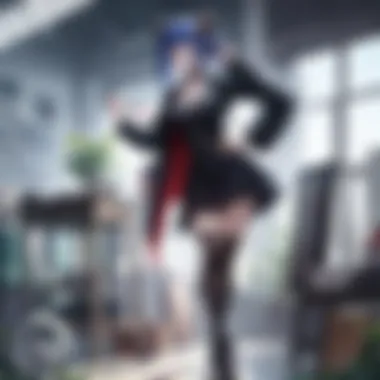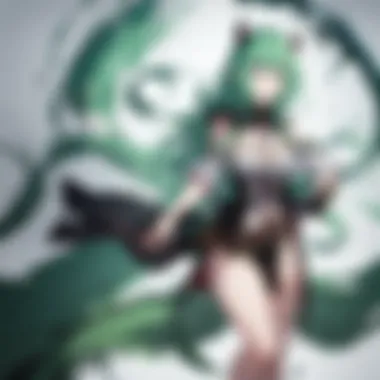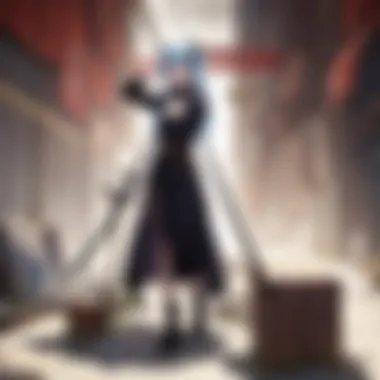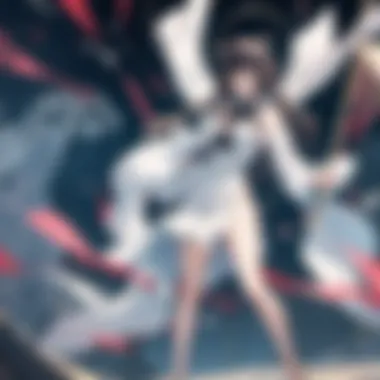Exploring the Animation Studio Behind Demon Slayer


Intro
The animation studio behind the acclaimed series Demon Slayer, Ufotable, has garnered significant attention due to its stunning visuals and innovative storytelling. In an era where anime continues to expand globally, understanding the dynamics of the studio that brought this series to life is essential. Ufotable's artistic direction, combined with technological advancements, sets it apart in the anime industry. This article will delve into various aspects of Ufotable, from its history to its creative approaches and the lasting impact of Demon Slayer on anime culture.
Series Overview
Synopsis and Premise
Demon Slayer follows the journey of Tanjiro Kamado, a young boy whose family is brutally murdered by demons, with the sole survivor being his sister, Nezuko, who is turned into a demon herself. The series unfolds as Tanjiro joins the Demon Slayer Corps to avenge his family and find a cure for Nezuko. The narrative explores themes of family, loss, and the struggle between good and evil.
Notable Characters
The series is rich in character development, showcasing a diverse cast. Key figures include:
- Tanjiro Kamado: The determined protagonist.
- Nezuko Kamado: Tanjiro’s sister, reluctantly transformed into a demon.
- Zenitsu Agatsuma: A fellow Demon Slayer with a unique and often comedic approach to battle.
- Inosuke Hashibira: A boar-headed fighter, known for his fierce persona and unpredictable tactics.
Themes and Motifs
Major Themes Explored
The narrative of Demon Slayer intertwines multiple themes, including perseverance in the face of adversity and the bonds of family. The series effectively showcases how love and determination can wield significant power even against tragedy.
Symbolism in Storytelling
Symbolism is prevalent throughout the series, from the significance of the Nichirin Blades to the various demon forms reflecting their human origins. These elements enhance the emotional depth and complexity of the story.
Artistic Style and Animation
Visual Aesthetics and Design
Ufotable’s artistic style is marked by its meticulous attention to detail and vibrant colors. The character designs are distinct yet relatable, bringing to life the world of demons and slayers seamlessly. The environments are dynamically rendered, creating an immersive viewing experience.
Animation Techniques and Trends
Ufotable employs cutting-edge technology to create fluid and dynamic animation sequences. Notably, they utilize a blend of traditional hand-drawn methods alongside CGI, enhancing both action scenes and emotional moments. This approach elevates Demon Slayer to stand out in the anime landscape, capturing audience engagement effectively.
"The artistic direction in Demon Slayer represents a significant leap in anime production, pushing boundaries and challenging conventions."
Prelude to Demon Slayer
Demon Slayer has emerged as a notable phenomenon in the anime industry, captivating audiences worldwide. This section sets the stage for understanding how the series fits into the broader context of anime. Its complex characters, engaging tales, and profound themes of family and perseverance resonate with viewers, making it essential to discuss its overall impact.
Overview of the Series
Demon Slayer is based on the manga written by Koyoharu Gotouge. It premiered as an anime in April 2019, produced by Ufotable. The story follows Tanjiro Kamado, a young boy living in the Taisho era of Japan. After his family is slaughtered by demons, he becomes a Demon Slayer himself to avenge his family and cure his sister Nezuko, who has been turned into a demon. The narrative intertwines action, emotion, and supernatural elements.
This series has quickly gained popularity, leading to significant discussions about its artistry and storytelling. The animation is particularly noteworthy, with its fluid action scenes and distinct color palettes capturing the viewers' attention. Such nuances make the series not only enjoyable but a subject worthy of deeper analysis.
Cultural Significance
Demon Slayer carries substantial cultural weight within and beyond Japan. It tackles issues such as grief, loss, and redemption, reflecting universal human experiences. The portrayal of Tanjiro embodies resilience and compassion, offering a role model for audiences. Furthermore, the series shines a light on Japanese culture, showcasing traditional values through its setting and character dynamics.
The anime has also achieved significant commercial success, influencing the manga market and various media adaptations. Items related to the series, such as merchandise and video games, have proliferated, indicating how it permeates popular culture. Not only does Demon Slayer entertain, but it also fosters community among fans, becoming a topic of conversation on platforms like Reddit and social media.
The Animation Studio: Ufotable
Ufotable plays a significant role in the creation of Demon Slayer, a series that has deeply influenced the anime landscape. This studio's unique approach combines masterful artistry with cutting-edge technology. The blending of skillful hand-drawn techniques and advanced computer-generated imagery results in an aesthetic that distinguishes Ufotable from its counterparts. Understanding Ufotable's history and its previous works helps illuminate its impact on the success of Demon Slayer.
Formation and History
Ufotable was founded in 2000 by former TMS Entertainment employees. The studio started with a vision to push the boundaries of anime production. Its emphasis on adopting innovative technologies has been a hallmark of its philosophy. Over the years, Ufotable built a reputation for handling significant projects, including adaptations of popular video game franchises. This background gave Ufotable the resources and experience necessary to develop its most notable work, Demon Slayer.


The studio quickly established itself as a prominent entity, known for its high production values. Collaborations with creators and original content creation have allowed Ufotable to flourish. It has attracted talent who share its vision for merging art and technology, resulting in a distinctive style that resonates with audiences.
Key Productions Prior to Demon Slayer
Before Demon Slayer, Ufotable produced several influential works that paved the way for its breakthrough. Noteworthy titles include the Fate series and Kara no Kyoukai. These productions showcased Ufotable's ability to capture emotional narratives through stunning visuals.
Fate Series
The Fate series, particularly Fate/Stay Night and Fate/Zero, demonstrated innovative storytelling. This franchise marked Ufotable's rise in the anime industry, as its animation quality set a new standard. The seamless blending of 2D characters with 3D environments became a signature aspect of their work.
Kara no Kyoukai
Kara no Kyoukai (The Garden of Sinners) showcased Ufotable's talent for intricate storytelling and exquisite art. The light novel adaptation featured profound philosophical themes, earning critical acclaim. The visual style employed in this series influenced subsequent projects, including Demon Slayer.
Artistic Philosophy of Ufotable
Ufotable stands out in the anime industry due to its unique artistic philosophy. The studio places a heavy emphasis on blending traditional animation techniques with modern technology. This integration not only enhances the visual appeal of their works but also elevates the storytelling experience. Ufotable’s dedication to artistry results in a rich tapestry of visuals that are both immersive and emotionally resonant.
Visual Style
The visual style of Ufotable is meticulous and striking. The studio first gained recognition for its lavish backgrounds and fluid character designs. Each frame is crafted with attention to detail. Ufotable utilizes a combination of 2D hand-drawn animation and sophisticated 3D technologies. This hybrid method allows for depth and dynamism in the animation. One notable aspect is how the use of lighting and color enhances the mood of each scene.
Another hallmark of their visual style is the incorporation of artistic elements from traditional Japanese aesthetics. This influences the overall presentation, making the visuals not just a backdrop, but a crucial part of the storytelling.
"Ufotable has made animation that feels like a painting come to life."
Elements such as
- Cinematic Techniques: Ufotable often employs camera angles and movement akin to film. This creates a dynamic viewing experience that captivates the audience.
- Special Effects: The studio is known for its innovative use of effects, particularly in action sequences where fluidity and energy are essential.
This visual approach connects deeply with audiences. It engages viewers, drawing them into the world of Demon Slayer. Each episode feels like an experience rather than mere entertainment.
Storytelling Techniques
Ufotable's storytelling techniques are just as significant as its visual style. The studio excels at illustrating deep narrative arcs while maintaining a clear focus on character development. This is seen through their pacing and framing of the storyline.
The narrative structure often mirrors the characters’ emotional states. As they undergo challenges, the storytelling adapts seamlessly, enhancing the viewer's emotional investment. Furthermore, Ufotable takes the time to develop backstories. Each character's history enriches the plot, making the stakes feel more substantial.
In addition, Ufotable's approach to dialogue is noteworthy. The studio expertly balances dialogue and visuals, allowing the animation to complement the narrative. This synergy ensures the pacing remains engaging without overwhelming the audience.
Other storytelling aspects include
- Thematic Depth: Themes of family, perseverance, and sacrifice run throughout the narrative.
- Flashbacks and Foreshadowing: These techniques provide insight and build suspense, keeping the audience engaged.
Overall, Ufotable’s artistic philosophy is pivotal. The balance of visual artistry and deep storytelling contributes significantly to the impact of Demon Slayer. Each episode serves as a testament to the studio's dedication to producing quality animated art.
Animation Technology and Innovation
Animation technology is central to the success of Demon Slayer. It not just defines the visual aesthetics but also enhances storytelling depth. Ufotable, the studio behind the series, employs advanced techniques that blend traditional and modern methods. This blend enables a dynamic presentation of emotions and actions, elevating the experience for viewers. The significance of this technology lies in how it shapes character engagement and the narrative flow.
2D and 3D Animation Integration
Ufotable is known for the seamless integration of 2D and 3D animation. This technique allows for fluid motion and intricate detail. The backgrounds, often richly textured, are created using 3D models. This model serves as a foundation. On top of it, traditional 2D animation brings the characters to life. The use of 3D aids in depth and perspective, providing a more immersive experience. It also helps in action sequences where depth perception is critical.
The benefits of this integration are manifold:
- Enhanced Visual Realism: 3D design contributes to a realistic feel.
- Dynamic Action Scenes: Movement and angles become more engaging.
- Consistent Quality: Easier to maintain high standards through technology.
This blending of styles is not merely functional. It creates a unique visual identity for Demon Slayer, setting it apart from other series.
Use of Visual Effects
Visual effects play a pivotal role in enriching the animation of Demon Slayer. Ufotable leverages state-of-the-art technology to enhance its storytelling. Effects such as dynamic lighting, particle effects, and fluid simulations are used extensively. These effects add layers of atmosphere and emotion to key scenes.


For example, during intense battles, the use of light flares and smoke creates a charged environment. This pulls the audience deeper into the narrative.
The visual effects also serve as a narrative device. They can signal shifts in emotion or amplify the stakes of a situation.
Here are some vital aspects of visual effects in Demon Slayer:
- Emotion Conveyance: Effects amplify the character's feelings.
- Immersive World-Building: Enhances the viewer’s sense of being in the story's universe.
- Symbolism: Certain effects hold significance beyond aesthetics, representing themes.
Character Design and Development
Character design and development play a crucial role in the overall success of an anime series, especially one as acclaimed as Demon Slayer: Kimetsu no Yaiba. This process involves crafting compelling visual identities that resonate with viewers, driving emotional engagement and contributing to storytelling. Ufotable's approach to character design has significant implications for audience reception and the series' cultural impact.
Character Aesthetics
The aesthetics of Demon Slayer characters are intricately woven into their personalities and roles within the story. Each character is visually distinct, with a design that conveys their unique traits, strengths, and vulnerabilities.
Consider Tanjiro Kamado, the protagonist. His character design incorporates features that symbolize his kind-hearted nature, such as the gentle expression and distinctive green and black checkered haori. Meanwhile, the character of Nezuko, his sister transformed into a demon, reflects her duality through her vibrant pink hair and the bamboo muzzle that hints at her struggle between human and demon identities.
Ufotable utilizes color schemes and clothing styles that are culturally significant yet modern. The designs evoke traditional Japanese aesthetics while appealing to contemporary tastes, making them easily recognizable in merchandising and fan art. Additionally, the attention to detail in facial expressions showcases a wide range of emotions, enhancing viewer connection to the characters.
Character Arcs
Character arcs are fundamental to the narrative structure in Demon Slayer; they demonstrate growth and development, which resonates deeply with the audience. Each character’s journey is crucial. Tanjiro's transformation from a caring brother to a skilled hunter embodies themes of perseverance and family bonds.
For instance, Zenitsu Agatsuma's arc reveals his evolution from a cowardly boy to a brave warrior. His growth is depicted not just through action but through his interactions with Tanjiro and Nezuko, showcasing a blend of vulnerability and bravery.
Furthermore, the relationships between characters add depth to these arcs. The dynamics between characters like Tanjiro and Giyu Tomioka highlight mentorship and the passing of knowledge. These layers create a richer narrative fabric and keep the audience engaged throughout the series.
The development of characters in Demon Slayer leads to multiple emotional payoffs. Through these carefully crafted arcs, viewers can relate to their struggles and triumphs, fostering a strong emotional investment in their outcomes. This investment contributes to the series' popularity and cultural resonance.
"Character design is not just about how a character looks, but how that design tells their story and connects with the audience on a deeper level."
Critical Reception of Demon Slayer
The critical reception of Demon Slayer plays a crucial role in understanding both the series and its animation studio, Ufotable. This section examines how Demon Slayer has been perceived by industry critics and audiences alike. Insight into this reception reveals significant factors that contributed to the show's popularity and cultural impact. This discussion also offers a lens through which to view the evolving standards within the anime industry and the artistic benchmarks set by Ufotable.
Industry Reviews
Industry reviewers have widely praised Demon Slayer for its innovation and quality. The series stands out not only for its story but also for its stunning animation. Critics often highlight the seamless integration of traditional 2D techniques with modern 3D elements. This balance enhances the overall viewing experience and sets a new standard in the anime landscape.
The choreography of fight scenes has also received commendation. Reviewers note that Ufotable's approach allows for visual storytelling that amplifies tension and excitement. Indeed, many industry experts declare that Demon Slayer has redefined action sequences in anime. Some significant points made by critics include:
- Visual Mastery: The detailed art and fluid animation capture nuances often overlooked in other series.
- Character Depth: Critics have appreciated the way backstories and motivations are weaved into the narrative, allowing viewers to connect with characters on a deeper level.
- Emotional Resonance: Many reviews emphasize how emotional beats are effectively depicted, adding layers to the overall narrative.
“Demon Slayer not only breaks records but raises the bar for what we expect from animation quality.” – Animation Journal
Audience Reception
Audience response to Demon Slayer has been overwhelmingly positive. Fans have taken to social media platforms and forums to express their admiration. Online discussions often revolve around character development, narrative arcs, and the exquisite art quality. The engagement within the community indicates that the series has fostered a sense of belonging among viewers.
Social media platforms, such as Reddit and Facebook, host a multitude of threads where fans analyze episode details, share fan art, and create theories about character motivations. This interaction not only demonstrates the fanbase's commitment but also enriches the viewing experience.
Some vital aspects of audience reception include:
- Cult Following: The series has garnered a dedicated fanbase who engage passionately with the content.
- Accessibility: Many viewers appreciate how the show balances intense themes with accessibility, making it inviting for newcomers to anime.
- Merchandising: The successful sale of merchandise is a testament to the show's popularity, reflected in various product lines that have emerged.
In summary, the critical and audience reception of Demon Slayer highlights its significance in shaping contemporary anime culture. Readers gain essential insight into how both industry experts and everyday viewers have responded, emphasizing the impact this series has had on the anime landscape.
Cultural Impact of Demon Slayer
The cultural impact of Demon Slayer extends far beyond its success as an anime series. It showcases the power of animation in influencing and shaping contemporary pop culture. This section examines the significance of Demon Slayer in modern society, particularly its role in revitalizing interest in anime and engaging a diverse audience.


Influence on Popular Culture
Demon Slayer has carved a unique niche in global popular culture. Its compelling storytelling and visually stunning artwork have transcended traditional fandom demographics. The series has attracted both seasoned anime viewers and newcomers alike.
The elements of traditional Japanese folklore interwoven in the narrative resonate with a broader audience, fostering a renewed appreciation for cultural heritage. Notably, characters like Tanjiro and Nezuko have become cultural icons. Their distinctive designs and relatable journeys contribute to their popularity.
Moreover, Demon Slayer has inspired countless memes, fan art, and discussion threads enriching online platforms. Websites such as reddit.com showcase thriving communities devoted to analyzing episodes, characters, and themes. The vibrant discourse surrounding the series has solidified its place in collective cultural consciousness.
"The cultural significance of Demon Slayer lies in how it connects people across various backgrounds, highlighting universal themes of perseverance and compassion."
Merchandising and Adaptations
The commercial success of Demon Slayer is undeniable, largely fueled by its extensive merchandising and adaptations. A multitude of products ranging from figurines to clothing helps keep the series fresh and relatable. Notable merchandise includes collectible items from brands such as Aniplex and Bandai. The reach of this merchandising goes beyond Japan, with products available globally, frequently sold out due to high demand.
Furthermore, the adaptation into movies, such as Demon Slayer: Mugen Train, has significantly contributed to its cultural standing. This film broke box office records, making it the highest-grossing anime film ever. It further solidified the Demon Slayer brand's influence and expanded its reach within the global market.
In addition to films, video games have emerged such as Demon Slayer: Kimetsu no Yaiba – The Hinokami Chronicles, engaging audiences through interactive storytelling.
Overall, Demon Slayer is not just an anime; it is a cultural phenomenon. Its impact on popular culture is profound, showcasing the ability of animation to connect with a worldwide audience. As it continues to evolve, the legacy of Demon Slayer in the anime community is assured, influencing future works and inspiring new artists.
The Future of Ufotable and Demon Slayer
The future of Ufotable and its flagship series, Demon Slayer, holds significant implications for the anime industry and its audience. As expectations for high-quality animation continue to rise, Ufotable remains at the forefront of innovation and creativity. The studio's ability to blend traditional and modern techniques ensures that future projects not only maintain the aesthetic standards set by Demon Slayer but also push the boundaries of what animation can achieve.
Upcoming Projects
Ufotable has hinted at several forthcoming projects that extend the Demon Slayer universe. The next season of the anime is highly anticipated, as it will adapt parts of the ongoing manga series. Fans are keen to see how Ufotable will handle new characters and complex narrative arcs. Additionally, there are discussions of movie adaptations of specific story arcs, which allow for a more cinematic approach to storytelling. The recent trend of expanding fictional universes suggests that Ufotable may explore spin-offs or side stories that deepen the lore of the Demon Slayer world.
Notable Projects on the Horizon:
- Season Three: Anticipated to continue where Season Two left off, it is expected to bring new battles and character developments.
- Feature Films: Potential adaptations of emotional key events in the manga, providing a fresh cinematic perspective.
Fans are also looking forward to collaborations with other projects. The success of Demon Slayer has put Ufotable in a prime position to participate in more cross-media ventures, integrating various forms of storytelling.
Continued Evolution of Animation
Ufotable's approach to animation reflects a commitment to evolving artistic methods. The integration of advanced technology, especially in the realm of 2D and 3D animation, is critical. As the landscape of animation shifts, studios need to adapt quickly to keep audiences engaged.
Some key trends influencing this evolution include:
- Realism in Animation: Ufotable aims to create immersive worlds that feel tangible and real. This requires constantly upgrading their technological capabilities.
- Dynamic Storytelling: By using innovative pacing and scene transitions, Ufotable enhances the narrative flow, making the experience more engaging for viewers.
- Audience Feedback: The studio listens to the fanbase, analyzing viewer preferences and reactions to refine their approaches.
The journey ahead for Ufotable and Demon Slayer is not merely about maintaining popularity. It is about fostering an artistic legacy that resonates with both viewers and fellow creators. As they continue to explore new technologies and storytelling methodologies, Ufotable is poised to influence future generations of animators.
"Innovation in animation is not just about new tools; it’s about enriching the viewer's experience and telling stories that connect deeply."
In summary, the future of Ufotable and Demon Slayer is bright with promise and potential. The studio must navigate challenges and expectations while continuing to infuse creativity into each new project. As they forge ahead, both fans and critics will be watching closely.
The End
In examining the significance of Ufotable and its production of Demon Slayer, it's essential to highlight the importance of this studio in shaping contemporary anime. Ufotable, known for its high-quality animations and innovative storytelling, has not only crafted a visually stunning series but also redefined audience expectations for anime production.
Reflections on Ufotable's Contribution
Ufotable's impact on the animation industry is profound. By merging traditional 2D animation with 3D elements, they have set a new standard for what viewers can anticipate in animation quality. Their dedication to detail extends beyond mere visuals; it’s in their ability to evoke deep emotional connections through their characters and narratives.
Some key aspects of Ufotable's contributions include:
- Attention to Detail: Ufotable meticulously crafts each frame, ensuring that every scene contributes meaningfully to the story.
- Innovative Techniques: The studio employs advanced technologies, blending 2D art with 3D models to create immersive worlds.
- Cultural Artistry: Ufotable pays homage to cultural elements, seamlessly incorporating them within the narrative, which enhances relatability for a broad audience.
Reflecting back, Demon Slayer illustrates the studio’s commitment to pushing boundaries in the animation medium, serving as a case study in quality over quantity.
Significance in the Anime Industry
The presence of Ufotable in the anime industry underscores the evolution of animation as a serious art form. The studio has paved the way for future productions through its excellence. The following points illustrate its significance:
- Setting New Benchmarks: Ufotable's pursuit of artistry raises standards, making it challenging for other studios to compete with the level of detail and emotional depth.
- Cross-Media Influence: Ufotable has bridged the gap between anime and video games, manifesting its animation skills across multiple platforms.
- Cultural Impact: Their work resonates globally, leading to increased interest in anime as a whole, influencing other creators to invest in quality storytelling.
In summation, Ufotable is not just a studio producing anime; it is a pivotal player influencing the trajectory of animation as a distinguished medium, enriching the global anime landscape.



